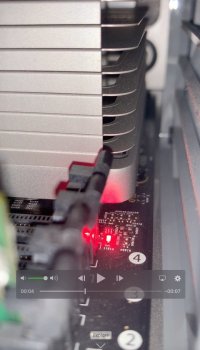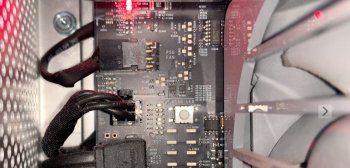I purchased this 12-Core Mac Pro 5,1 (see my sig) as-is a few weeks ago from a local reseller for a very low price. They had almost two dozen they were looking to move and in hindsight. I probably should have bought two for parts redundancy alone.
My plan was to spec it out (mostly for photo editing, with possibly some video editing and music creation as well--I’m a gaming tee-totaler.) I built my first computer around a Pentium II back in 1998, but in the last 10 years my hardware tinkering has consisted of only ram upgrades and data doubler SSD for optical drive swaps to multiple 2012 MBPs.
Immediately after purchase I plugged the 5,1 in to check it out, mostly to make sure a.) it worked and b.) the specs I was quoted were accurate. Foolishly, I did NOT run any real diagnostics at this time (wouldn't even know what to run tbh.) I just turned the machine off and continued my crash course on all of the possibilities in upgrading this machine.
Fast forward 3-1/2 weeks to two nights ago, and I’ve finally decided what I was upgrading (almost everything) and picked out, ordered and received all the new components. Even though I was still waiting on some HDDs for an internal RAID array, I had pretty much figured out my order of operations and was ready to begin.
But right off the bat I think I might have effed up. I opened the 5,1 and used this Metro Vacuum DataVac Pro to suck (with the straw type attachment with bristles) away some dust bunnies. In doing this I only touched the aluminum just in front of the old 5770 GPU and on the aluminum behind the PCIe fans (far left) of the middle compartment. I may have slightly brushed the 5770 once. I didn’t come near any other components or boards.
I then realized this was ill-advised and I hadn’t read at all in detail if this device was actually ESD proof or not or if this was even a good idea and stopped. Instead I switched it to blow and proceeded to blow a metric fton of dust out from everywhere in the machine (especially the CPU tray and the heat sinks, which I blew out while it was removed and set on my glass coffee table.) Before blowing inside the tower sans CPU tray, I tried to secure the PCIe fan by simply sticking a small rigid plastic pipe hose attachment from the Datavac through it so it would not spin up. I did NOT do the same with the CPU tray fans (because I wasn’t aware of them before I started blowing) but did not observe any movement from them throughout. At this time I did NOT blow out from within the optical drive bay or the PSU.
I pressed the power-on button and that button’s white LED came on. It chimed, the screen (a 42” TV monitor connected by HDMI with HDMI-DVI dongle) went white grey, and shortly thereafter I saw the Apple logo and a thin black progress bar. After it gets to about 20% the machine dies altogether.
Try this again and it happens again. And again.
At this point I tried resetting the NVRAM and the SMC. Then I tried replacing the BR2032 battery but all I had on hand was an old CR2032. Then I tried removing all RAM sticks except for one 4gb stick in slot 1. At some point within this phase, I stopped getting the white grey screen and apple logo and instead the machine would just die after a second or two, no chime.
Also during this phase, I can't tell you why exactly, but I may have held down the startup button for 5-6 seconds. From my reading this shouldn’t matter, but I was worried for a second I may have inadvertently initiated a firmware update attempt that then failed thereby bricking my system. But my CD tray never opened, so I’m not so sure. From my limited reading on that subject, it seems like I would need to have initiated this update from within macOS and my worry here is unwarranted.
Through this whole time, the cMP is plugged into a 1500va APC-UPS. During one of my early boot attempts I did watch the load bars on the UPS and saw the third bar appear (signifying 60% of the load according to the BR1500ms manual) just before the machine died. I then attempted to plug in to the wall directly but that changed nothing.
When I press the power-on, the top two diag LEDs (OVTMP CPUA & OVTMP CPUB) flash red. When the machine is off, only the 5V STANDBY amber LED can be seen when I press the diag LED button.
Watching the video of a startup attempt, the PCIe fan starts and run for about 1.5-2 seconds and then stop. I believe the CPU tray fans are the same. There is also a red LED on the CPU tray that flashes. It is labelled R1511.
I don't know how to attach video to this post, but you can see screen shots stills from both the videos in question.
I tried removing all RAM sticks, the HDD, the optical drive, the GPU and booting like that and nothing changed.
The strange thing was the next morning, I tried to power-on again and this time I heard a chime but it died again some time later (can't recall if i saw an apple logo or not.)
After reading as much as I could on this forum, Reddit and apple forums over the last 48 hours, I am at a loss. I’m guessing it is either the PSU, the backplane, the CPU tray, Northbridge spring rivets?
Should I try the new GPU or the new RAM? CMIIW but it seems like its not the RAM or the GPU because of the way removing both completely didn't seem to change anything with the diag LEDs.
Any and all help would be greatly appreciated.
My plan was to spec it out (mostly for photo editing, with possibly some video editing and music creation as well--I’m a gaming tee-totaler.) I built my first computer around a Pentium II back in 1998, but in the last 10 years my hardware tinkering has consisted of only ram upgrades and data doubler SSD for optical drive swaps to multiple 2012 MBPs.
Immediately after purchase I plugged the 5,1 in to check it out, mostly to make sure a.) it worked and b.) the specs I was quoted were accurate. Foolishly, I did NOT run any real diagnostics at this time (wouldn't even know what to run tbh.) I just turned the machine off and continued my crash course on all of the possibilities in upgrading this machine.
Fast forward 3-1/2 weeks to two nights ago, and I’ve finally decided what I was upgrading (almost everything) and picked out, ordered and received all the new components. Even though I was still waiting on some HDDs for an internal RAID array, I had pretty much figured out my order of operations and was ready to begin.
But right off the bat I think I might have effed up. I opened the 5,1 and used this Metro Vacuum DataVac Pro to suck (with the straw type attachment with bristles) away some dust bunnies. In doing this I only touched the aluminum just in front of the old 5770 GPU and on the aluminum behind the PCIe fans (far left) of the middle compartment. I may have slightly brushed the 5770 once. I didn’t come near any other components or boards.
I then realized this was ill-advised and I hadn’t read at all in detail if this device was actually ESD proof or not or if this was even a good idea and stopped. Instead I switched it to blow and proceeded to blow a metric fton of dust out from everywhere in the machine (especially the CPU tray and the heat sinks, which I blew out while it was removed and set on my glass coffee table.) Before blowing inside the tower sans CPU tray, I tried to secure the PCIe fan by simply sticking a small rigid plastic pipe hose attachment from the Datavac through it so it would not spin up. I did NOT do the same with the CPU tray fans (because I wasn’t aware of them before I started blowing) but did not observe any movement from them throughout. At this time I did NOT blow out from within the optical drive bay or the PSU.
I pressed the power-on button and that button’s white LED came on. It chimed, the screen (a 42” TV monitor connected by HDMI with HDMI-DVI dongle) went white grey, and shortly thereafter I saw the Apple logo and a thin black progress bar. After it gets to about 20% the machine dies altogether.
Try this again and it happens again. And again.
At this point I tried resetting the NVRAM and the SMC. Then I tried replacing the BR2032 battery but all I had on hand was an old CR2032. Then I tried removing all RAM sticks except for one 4gb stick in slot 1. At some point within this phase, I stopped getting the white grey screen and apple logo and instead the machine would just die after a second or two, no chime.
Also during this phase, I can't tell you why exactly, but I may have held down the startup button for 5-6 seconds. From my reading this shouldn’t matter, but I was worried for a second I may have inadvertently initiated a firmware update attempt that then failed thereby bricking my system. But my CD tray never opened, so I’m not so sure. From my limited reading on that subject, it seems like I would need to have initiated this update from within macOS and my worry here is unwarranted.
Through this whole time, the cMP is plugged into a 1500va APC-UPS. During one of my early boot attempts I did watch the load bars on the UPS and saw the third bar appear (signifying 60% of the load according to the BR1500ms manual) just before the machine died. I then attempted to plug in to the wall directly but that changed nothing.
When I press the power-on, the top two diag LEDs (OVTMP CPUA & OVTMP CPUB) flash red. When the machine is off, only the 5V STANDBY amber LED can be seen when I press the diag LED button.
Watching the video of a startup attempt, the PCIe fan starts and run for about 1.5-2 seconds and then stop. I believe the CPU tray fans are the same. There is also a red LED on the CPU tray that flashes. It is labelled R1511.
I don't know how to attach video to this post, but you can see screen shots stills from both the videos in question.
I tried removing all RAM sticks, the HDD, the optical drive, the GPU and booting like that and nothing changed.
The strange thing was the next morning, I tried to power-on again and this time I heard a chime but it died again some time later (can't recall if i saw an apple logo or not.)
After reading as much as I could on this forum, Reddit and apple forums over the last 48 hours, I am at a loss. I’m guessing it is either the PSU, the backplane, the CPU tray, Northbridge spring rivets?
Should I try the new GPU or the new RAM? CMIIW but it seems like its not the RAM or the GPU because of the way removing both completely didn't seem to change anything with the diag LEDs.
Any and all help would be greatly appreciated.
Attachments
As an Amazon Associate, MacRumors earns a commission from qualifying purchases made through links in this post.



